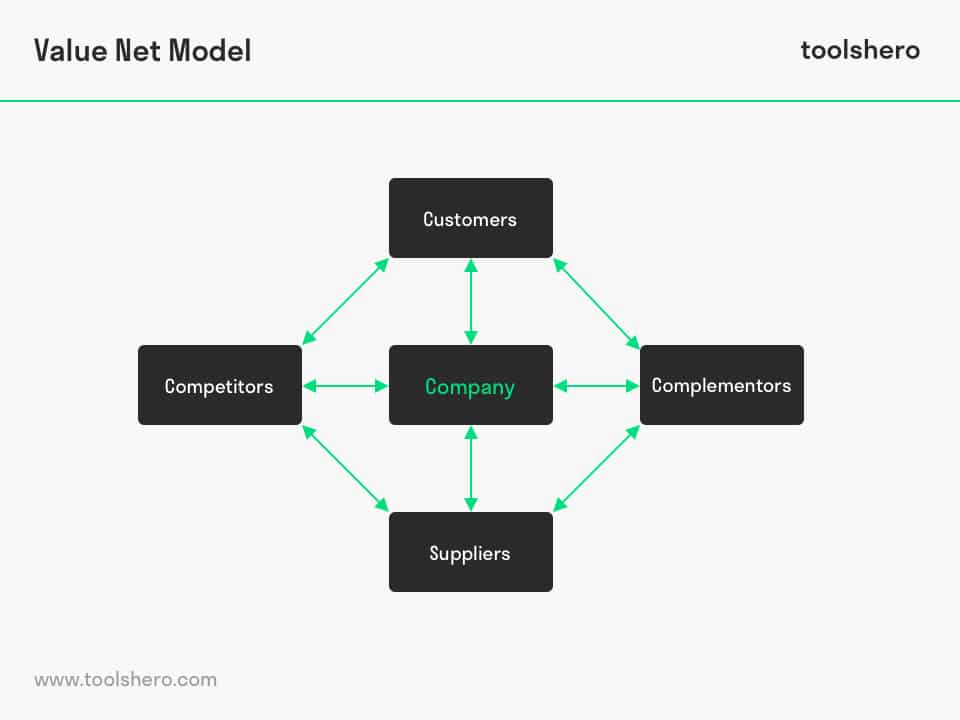Value Net Model

Value Net Model: this article provides a practical explanation of the Value Net Model, developed by Adam Brandenburger and Barry Nalebuff. After reading,After reading, you’ll understand the basics of this powerful strategic management and transformation tool.
What Is the Value Net Model?
The Value Net Model (VNM), developed by Adam Brandenburger and Barry Nalebuff is a strategic framework with which organisations can classify relevant actors in their branch and their surroundings.
The VNM identifies four types of players with which every company must work, and who have a direct influence on the company, and its results: customers, suppliers, competitors and complementary members.
Every player, all equal in value according to the Value Net Model, offers opportunities for cooperation with the organisation, including competition. For example, one of these four can take on several roles. A company can be both a supplier and competitor, and both a customer as well as supplier.
The VNM is based, among others, on the Five Forces Model by Michael Porter and elaborated on by Barry Nalebuff, professor at Harvard University, and Adam Brandenburger, professor at Yale University.
In their view, Porter’s Five Forces Model concentrated entirely on competition and failed to evaluate cooperation potential in industries, which could precisely lead to a lot of value creation. When companies in a certain industry work together, they can create a larger and more valuable market than they could ever achieve working alone. This means players in the industry should focus more on the total market potential and allow it to grow rather than on dividing the market potential and trying to win individual market share.
Value Net Model: players in the value chain, including examples
The starting point of the Value Net Model is to consider business as a game and to model who the players in the game are, what their roles are and what their net worth is. The goal of every ambitious company is to grow.
The total balance of value consists of customers, suppliers, competitors and complementors / complementary members. The result is a complete overview of the company and environment. The following four players in the game are identified in the model:
Customers
Without customers, a company does not have much chance of survival. More customers means more sales and probably a larger market share. Customers can either be home users or other companies in the case of business 2 business.
Porter labelled this category as buyers. A clearly segmented group of buyers must be defined and all company activities must be focused on recruiting as many customers as possible.
Suppliers
The suppliers are the parties that provide an organisation with the resources needed to produce or sell the final product. Resources are important external factors to take into account, because suppliers have a direct influence on the price at which they are supplied and quality of the end product.
Maintaining good relationships with suppliers or risk distribution, by choosing several suppliers, is therefore highly recommended. Suppliers play a key role in future success and shouldn’t be neglected. The Kraljic Portfolio Purchasing Model is a tool for choosing the right strategy for suppliers.
Competitors
Both the Porter’s Five Forces Model and Porter Diamond Model describe the need to analyse the competition.
In most markets there are several competitors: those who compete on price and those who compete on quality. Knowing one’s competition has long been a crucial success factor, which will always be the case.
Although competitors are often seen as players with whom one has to fight for market share, it is also possible to cooperate and increase profitability. An example of this is the joint purchase of resources from suppliers.
If everything is purchased in bulk, discounts can be given and the costs per production unit can be reduced. Such an alliance was started in 1999 by Renault and Nissan. By joining forces, they could benefit from each other’s complementary possibilities. Renault benefited from Nissan’s excellent production capabilities and Nissan benefited from Renault’s strong financial position.
Complementary members
This is the category for which Nalebuff and Brandenburger have partly came up with the Value Net Model. Rather than just competing with similar companies in the market, this category describes why competitor products and services can be combined to make the end result more attractive to consumers.
Players are considered complementary members if the consumer appreciates the product while another’s company product is incorporated therein or when he owns both products. By being open to such partnerships and other types of agreements, a company can potentially grow further than what could have been achieved individually.
Applying The Value Net Model
The VNM is a visual model and can be drawn with pen and paper or software. The most important part of this process is identifying the company’s most influential business and economic relationships. This includes the four players in the game from the Value Net Model: competitors, suppliers, customers and complementary members.
Sort this list based on significance, the most important relationships at the top. Then start by critically reviewing the relationships and identify the potential of each group. Conduct a competition analysis to determine the influence of competitors on your customers and business operations and assume that suppliers are a major risk. Consider working together with a rival to enforce cheaper purchasing prices.
The Value Net Model is ideal for companies that work with unprocessed materials and capital goods, because the distinction between competition, suppliers and complementary members is clearer. Every company that falls into this category benefits from carrying out an analysis based on the Value Net Model.
At the same time, other companies may also benefit from applying the Value Net Model. After all, every company has multiple economic and business relationships, and there may be hidden potential that is not being fully utilised.
Pros and Cons of the Value Net Model
Pros:
- The Model is based on the principles of game theory
- The Value Net Model elaborates on the idea that cooperation is at least as important in business as competition, and that competition and cooperation can complement each other.
- In contrast to the Five Forces Model, which focuses on a particular industry, Brandenburger and Nalebuff involve different industries in the model to stimulate interesting business opportunities and ideas.
Cons:
- The Value Net Model can be considered highly abstract, because the definition of competitors and complementary members is broad.
- The Value Net Model stimulates creative thinking but does not offer a clear answer to everyday business problems.
- Because of its common ground with the game theory, the Value Net Model also reflects the weaknesses of this model. As more players or options are added, the application of the theory becomes more complex.
Now it’s your turn
What do you think? Are you familiar with this explanation of the Value Net Model? How do you apply the Value Net Model in your company? What do you think are the factors necessary to successfully analyse an organisation’s environment as accurately as possible? Do you have any tips or additional comments?
Share your experience and knowledge in the comments box below.
More information
- Nalebuff, B. J., Brandenburger, A., & Maulana, A. (1996). Co-opetition. London: HarperCollinsBusiness.
- Nalebuff, B. J., & Brandenburger, A. M. (1997). Co-opetition: Competitive and cooperative business strategies for the digital economy. Strategy & leadership, 25(6), 28-33.
- Da-li, H. U. (2006). Study of Enterprise Competitive Strategy Based on Value Net Model [J]. China Industrial Economy, 9, 010.
How to cite this article:
Janse, B. (2018). Value Net Model. Retrieved [insert date] from Toolshero: https://www.toolshero.com/strategy/value-net-model/
Published on: 12/04/2018 | Last update: 05/12/2022
Add a link to this page on your website:
<a href=”https://www.toolshero.com/strategy/value-net-model/”>Toolshero: Value Net Model</a>













